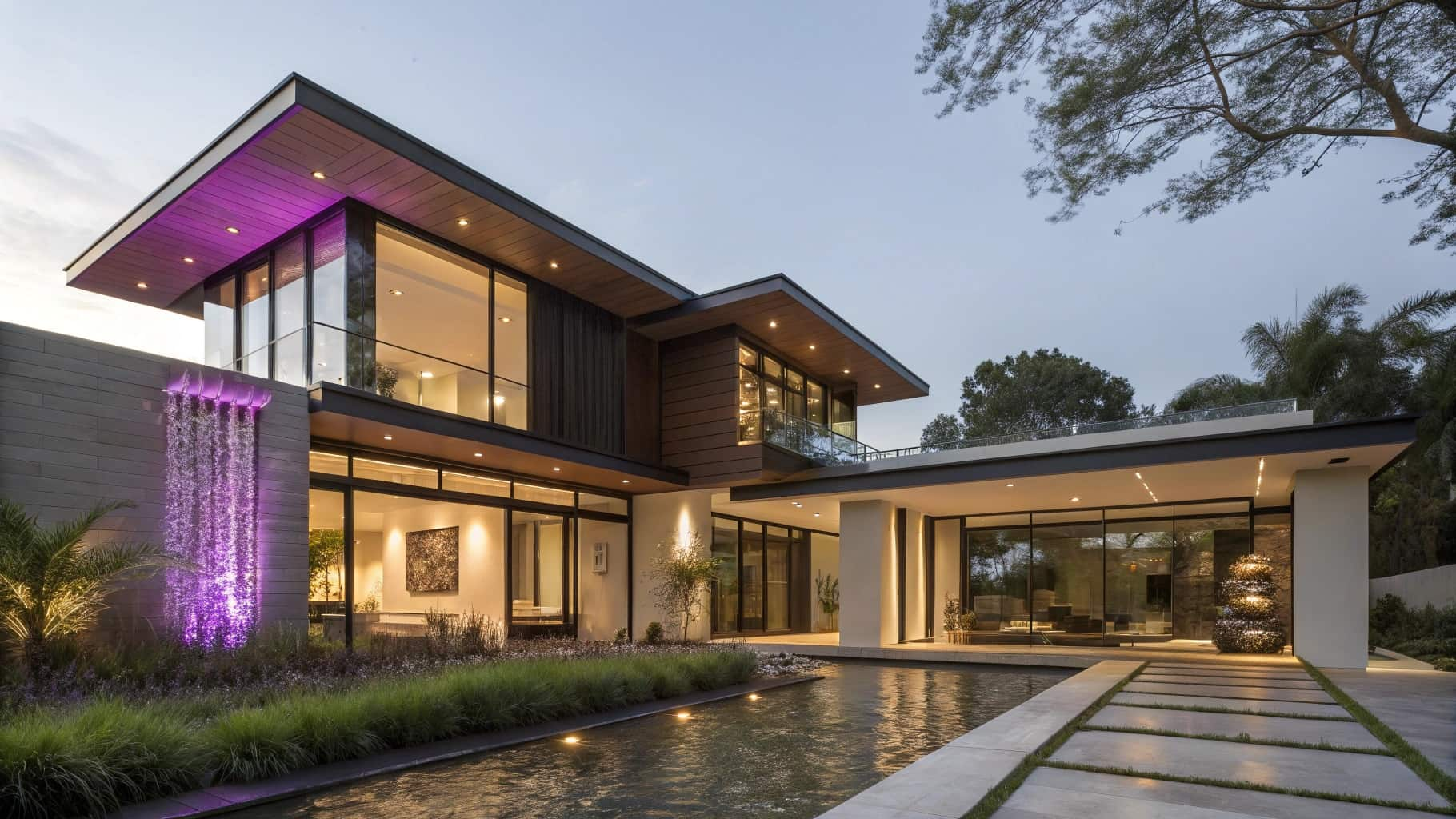Rainwater harvesting is an ancient practice that has gained renewed interest in recent years, particularly in the context of sustainable living and environmental conservation. This method involves the collection and storage of rainwater for various uses, including irrigation, potable water supply, and even household needs. The process typically involves capturing rainwater from rooftops or other surfaces, directing it through a system of gutters and downspouts, and storing it in tanks or cisterns.
As urban areas expand and water scarcity becomes a pressing issue, rainwater harvesting presents a viable solution that not only conserves water but also reduces reliance on municipal water systems. In luxury homes, where aesthetics and functionality often go hand in hand, rainwater harvesting systems can be seamlessly integrated into the overall design. These systems not only provide an eco-friendly alternative to traditional water sources but also enhance the value of the property.
Homeowners are increasingly recognizing the importance of sustainability, and rainwater harvesting serves as a practical demonstration of their commitment to environmental stewardship. By utilizing this resource, luxury homeowners can enjoy the benefits of reduced water bills, increased self-sufficiency, and a smaller ecological footprint.
Benefits of Rainwater Harvesting in Luxury Homes
The advantages of rainwater harvesting extend far beyond mere water conservation. For luxury homeowners, one of the most compelling benefits is the potential for significant cost savings. By capturing and utilizing rainwater for irrigation and non-potable uses such as toilet flushing and laundry, homeowners can drastically reduce their dependence on municipal water supplies.
This reduction not only translates into lower water bills but also mitigates the impact of rising water costs associated with urban development and climate change. Moreover, rainwater harvesting systems can enhance the overall aesthetic appeal of luxury properties. With careful design, these systems can be integrated into the landscape in a way that complements the home’s architecture.
For instance, decorative cisterns can serve as focal points in gardens or courtyards, while rain gardens can be designed to manage stormwater runoff effectively. This integration not only promotes sustainability but also elevates the property’s market value by showcasing a commitment to innovative and responsible living.
Components of a Rainwater Harvesting System
A comprehensive rainwater harvesting system consists of several key components that work together to ensure efficient collection, storage, and distribution of rainwater. The first component is the catchment area, typically the roof of a building, which collects rainwater as it falls. The material of the roof is crucial; for instance, metal roofs are often preferred due to their smooth surfaces that facilitate water flow and their non-toxic nature.
Following the catchment area, gutters and downspouts play a vital role in directing the collected rainwater into storage tanks. These components must be properly sized and installed to handle varying rainfall intensities while minimizing overflow and ensuring that debris does not enter the system. The storage tank itself is another critical element; it can be above ground or underground, depending on space availability and aesthetic considerations.
Tanks are usually made from materials such as polyethylene, fiberglass, or concrete, each offering different benefits in terms of durability and insulation. The final components include filtration systems and pumps. Filtration is essential to remove debris and contaminants from the collected rainwater before it is stored or used.
Various filtration methods exist, ranging from simple mesh screens to more advanced sediment filters. Pumps are necessary for distributing the harvested rainwater throughout the home or landscape, ensuring that it is readily available for irrigation or other uses.
Design Considerations for Rainwater Harvesting in Luxury Homes
When designing a rainwater harvesting system for luxury homes, several factors must be taken into account to ensure optimal performance and aesthetic integration. One primary consideration is the size of the catchment area and storage capacity. The design should account for local rainfall patterns to determine how much water can realistically be harvested throughout the year.
This analysis helps homeowners decide on the appropriate size for their storage tanks and whether additional features, such as overflow systems or secondary tanks, are necessary. Aesthetic considerations are equally important in luxury home design. Homeowners often seek to maintain a cohesive look throughout their property, which means that rainwater harvesting systems should blend seamlessly with existing architecture and landscaping.
For example, cisterns can be designed to mimic other outdoor structures or can be concealed within garden beds to maintain visual appeal. Additionally, integrating smart technology into the system can enhance functionality while providing an elegant touch; automated controls can monitor water levels and manage distribution without requiring constant manual oversight.
Maintenance and Upkeep of Rainwater Harvesting Systems
Regular maintenance is crucial for ensuring the longevity and efficiency of rainwater harvesting systems. Homeowners should establish a routine inspection schedule to check for debris accumulation in gutters and downspouts, as well as any signs of wear or damage in storage tanks and filtration systems. Cleaning gutters at least twice a year is recommended to prevent blockages that could lead to overflow or contamination of stored water.
In addition to physical inspections, homeowners should also monitor water quality regularly. Testing for contaminants such as bacteria or heavy metals is essential, especially if the harvested rainwater is intended for potable use. If issues are detected, appropriate treatment methods—such as UV disinfection or advanced filtration—should be employed to ensure safety.
Furthermore, seasonal adjustments may be necessary; for instance, during dry months, homeowners might need to supplement their harvested water with municipal supplies or implement conservation measures to extend their water supply.
Legal and Regulatory Considerations for Rainwater Harvesting
Before implementing a rainwater harvesting system, luxury homeowners must navigate various legal and regulatory frameworks that govern water collection practices in their region. In many areas, local laws dictate how much rainwater can be harvested and whether permits are required for installation. Some jurisdictions encourage rainwater harvesting through incentives or rebates, while others may impose restrictions based on environmental concerns or water rights.
Homeowners should consult with local authorities or legal experts to ensure compliance with all regulations before proceeding with installation. This may involve submitting plans for approval or adhering to specific guidelines regarding system design and maintenance. Understanding these legalities not only helps avoid potential fines but also ensures that the system operates within established environmental standards.
Cost and Return on Investment for Rainwater Harvesting in Luxury Homes
The initial investment required for a rainwater harvesting system can vary significantly based on factors such as system size, complexity, and local installation costs. On average, homeowners might expect to spend anywhere from $5,000 to $20,000 for a complete system that includes catchment areas, storage tanks, filtration units, and pumps. While this upfront cost may seem substantial, it is essential to consider the long-term savings associated with reduced water bills and potential increases in property value.
Calculating return on investment (ROI) involves assessing both tangible and intangible benefits over time. For instance, if a luxury home saves an average of $500 annually on water bills due to its rainwater harvesting system, the payback period could be relatively short—potentially within 10-20 years depending on initial costs and local water rates. Additionally, many luxury homeowners find value in the environmental benefits associated with sustainable practices; this commitment can enhance their reputation within their community while contributing positively to global conservation efforts.
Case Studies of Successful Rainwater Harvesting in Luxury Homes
Several luxury homes around the world have successfully implemented rainwater harvesting systems that serve as exemplary models for others considering similar projects. One notable case is a high-end residence in California’s Napa Valley that utilizes an extensive rainwater collection system integrated into its landscape design. The home features a series of beautifully landscaped gardens equipped with underground cisterns that capture runoff from both the roof and surrounding hardscapes.
This innovative approach not only provides irrigation for lush gardens but also enhances the property’s aesthetic appeal. Another inspiring example comes from a luxury estate in Australia that has adopted cutting-edge technology in its rainwater harvesting system. This home employs smart sensors that monitor rainfall levels and automatically adjust irrigation schedules based on current weather conditions.
The system is designed to optimize water usage while maintaining the health of its expansive gardens and lawns. By showcasing such advanced technology alongside sustainable practices, this estate has set a benchmark for luxury homes aiming to balance elegance with environmental responsibility. These case studies illustrate how luxury homeowners can creatively integrate rainwater harvesting systems into their properties while reaping significant benefits—both financially and environmentally—demonstrating that sustainability can indeed coexist with opulence.
FAQs
What is rainwater harvesting?
Rainwater harvesting is the collection and storage of rainwater for later use. It involves capturing rainwater from surfaces like rooftops and storing it in tanks or cisterns for various purposes such as irrigation, toilet flushing, and laundry.
How does rainwater harvesting work in luxury homes?
In luxury homes, rainwater harvesting systems typically involve the installation of gutters and downspouts to capture rainwater from the roof, which is then directed to a storage tank or cistern. The collected rainwater is then filtered and treated for use in landscaping, flushing toilets, and other non-potable water needs.
What are the benefits of rainwater harvesting in luxury homes?
The benefits of rainwater harvesting in luxury homes include reducing reliance on municipal water sources, lowering water bills, and promoting sustainability. Additionally, using harvested rainwater for irrigation can help maintain lush landscaping without putting a strain on local water resources.
Are there any considerations for implementing rainwater harvesting in luxury homes?
When implementing rainwater harvesting in luxury homes, it’s important to consider factors such as the size of the roof, the amount of rainfall in the area, the quality of the collected rainwater, and the maintenance requirements of the system. Additionally, local regulations and building codes may need to be considered.
Is rainwater harvesting a sustainable practice for luxury homes?
Yes, rainwater harvesting is a sustainable practice for luxury homes as it reduces the demand for potable water and helps conserve natural resources. By utilizing rainwater for non-potable purposes, luxury homes can contribute to environmental conservation and reduce their ecological footprint.

